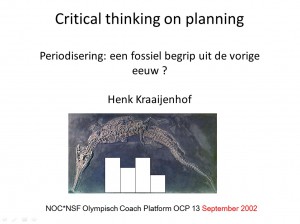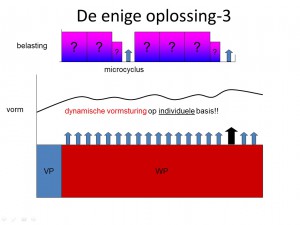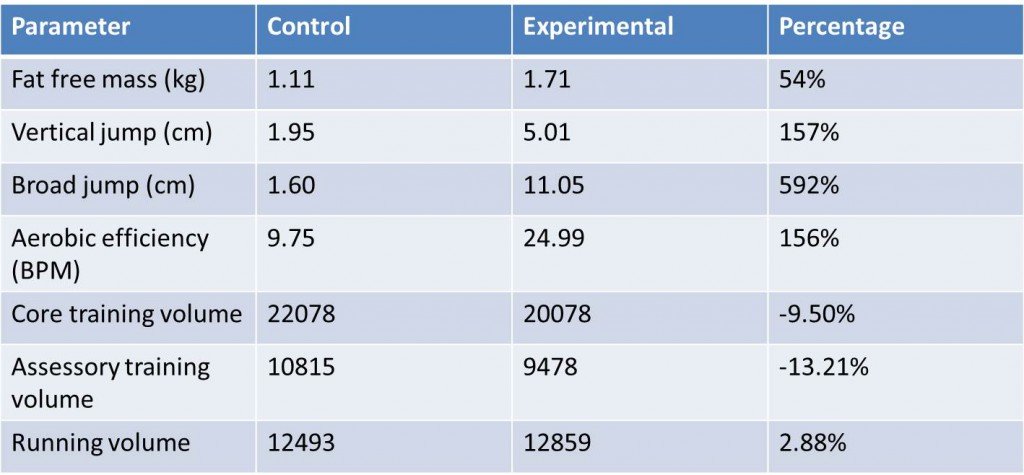Back in 2002 I was invited to give a presentation for the national Olympic coaches at our Olympic Coaches Platform. The title: Periodization: a fossil from the 21 century?


It was a critical view on the “classic” periodization models in which the most dominant missing factors were: individuality and dynamics. Most periodization models are based on average responses to average training loads. Of course, such an approach can only produce average athletes delivering average performances. But also missing was the dynamics flexibility based on the variation in training response.
If two athletes A and B do the same standardized training, athlete A might have a positive response and improve in performance, while athlete B, might be flat, tired, overtrained or injured. In my opinion the training program for athlete B should be changed and differ from that for athlete A. But also a program that might lead to improvement for athlete A in period 1, might lead to no response or a negative response in period 2. The same thing applies to a team: where a certain way of planning might improve performance in the first half of the season, that same planning might not work out well in the second half!
That is why I introduced the expression: dynamic programming, which means that the next program or cycle depends on the response on the first cycle. And the second cycle is not statically programmed beforehand. So the main principle becomes clear: the periodization depends on and gets its feedback from the actual status of the athlete. In an ideal situation this should even be done on a daily basis!
We can also call this dynamic programming: fluid periodization, in contrast to the usual static programming or rigid periodization.
The big question is ……. does dynamic programming or fluid periodization really work? That is to say: is dynamic programing superior in results to static programming?
One of the tools we use to measure the actual status of the athletes is the Omegawave (Coach) system. So instead of just blindly following the paper training program plan A, I use the Omegawave to measure whether the athlete is able to adapt optimally to the suggested program, plan A, or is better to change to plan B.
One of the first researches in this field is done by Dr.Starodubtsev, who in his dissertation from 1999 compared static programming in a control group, with dynamic programming dependent on the outcome of the Omegawave tests in an experimental group of middle-distance runners.(1)
Let me summarize the results only after one year:
 I can only conclude that there is a considerable difference in improvement between these two groups.
I can only conclude that there is a considerable difference in improvement between these two groups.
Recently another Ph.D. thesis was published, based on the same set-up: comparing the performance improvement from a static periodized group with a dynamic periodized group, based on the feedback of the outcome of the Omegawave tests. The research was conducted with 61 collegiate American football players over 8 weeks of training
Again the difference in results is extremely interesting. 28% of the workouts in the experimental group were adjusted based of the outcome of the daily Omegawave tests. And also the experimental group performed less volume in strength work than the experimental group in those 8 weeks. Remember, these are differences over an 8 weeks period only, just imagine what would happen after 8 months.
Just a few highlights to think about:
I think the answer is quite clear and expected: adjusting the daily training load to the actual status of the individual athlete will give the coach a superior training effect and therefor an optimal starting point for improved performance and less risk of injuries.
This approach, when applied systematically and continuously will be the biggest leap forward in unleashing the genetic potential of our athletes. Also since this is at the very core of our work as coaches: applying the individual optimal training load on a daily basis.


I really enjoyed this post. Very thought provoking and in reality, I think it should be fairly obvious!
David, thanks for your comment. You are right, it should be fairly obvious, but in real life, the obvious isn’t, and common sense and common knowledge are not that common. Modern men ignores, neglects or downplays the obvious and the common. He/she instead looks for “new and improved”, the “innovative”, the “revolutionary”, the “sexy”, the “cool”, the “hot”, “the secret”, “the gadget”, “the gimmick”, “the system”, “the program”, the “golden” exercise, the discrepancy or the overlap, the instant solution to the eternal problem.
One of the pillars of successful training is to do what everybody “knows” they should do, but in reality nobody does, because it is too obvious….
Thank you for your writings. I agree with your training philosophy and practices. I coach freshman football at our local high school and dealings with coaches has been a bit frustrating only hearing that static training is best. I work with individual athletes in different sports and they’re showing better results than the usual. Thanks again.
Hi,
thanks for that post and your whole blog in general. Very interesting stuff.
If you look at the “old school” russian literature on physioligy and exercise science ( like Verkhoshansky, Issurin and Zatsiorsky) , I always liked the way they described training as an control theory problem (https://en.wikipedia.org/wiki/Control_theory).
I think the “Black box” approach comes to mind here (https://en.wikipedia.org/wiki/Black_box)
At the end of the day this is what you try to do: vary the input/signal (training stimulus and recovery means) to a system (the athlete) that is not well understood and/or to complex to predict its reactions to the signal in order to influence the outcome.
I really agree with you that studies (often with extremlky small sample size) that look for correlations and average effects are at best an indication of what to try out next.
Edit: as an aside, if you still considering it I think you should settle for “fluid periodisation” as a name for your concept. Since “dynamic programing” is a well known technique in optimization.
Regards
Philipp